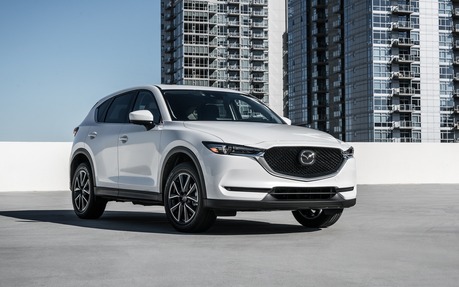Mazda CX-5: The It Factor
The CX-5 compact SUV has the “it” factor. Although taste is subjective, even those who don’t like the CX-5’s style have to admit that it has a dynamic look. This SUV was updated this year and now shares several style features with its big brother, the CX-9, in particular for the front end.
Rather than spending huge sums to develop new platforms, new engines and cutting-edge technology, Mazda opened up its bag of tricks and refined some of its existing elements. That's how SKYACTIV technology was born: it's a simple solution that is relatively low-cost to produce and maintain—and it works! Mazda's products have a little added soul, that indefinable charm, that little spark that makes them fun to drive.
Lots of details, little connectivity
A bunch of elements have been updated, including the design of the door handles, exterior rearview mirrors and back doors, which now open wider.In the passenger compartment, the console is higher than it used to be and there’s a tablet-like screen at the top of the dashboard. Using this screen and a dial on the central console, you access to an often non-user-friendly infotainment system. Expect a steep learning curve for the navigation syste,.Furthermore, at the CX-5 launch, Mazda said it was still working on integrating Apple CarPlay and Android Auto, which have been offered by almost all other manufacturers for years.
- Also: Mazda to Offer an Electric Vehicle by 2019
- Also: 2017 Mazda CX-5: Ready to Take on the Big Boys
As for the engine, it’s pretty much the status quo compared to previous years. Mazda is still offering a 2.0-litre four-cylinder that generates 155 horsepower in the basic version. This engine can be paired with a six-speed manual or automatic gearbox. With the manual, only front-wheel drive is available.This engine isn’t in its element in a CX-5; it’s a little more at home in the CX-3, but even then, despite the vehicle being about 300 kilos lighter, it’s far from explosive. It isn’t very effective in the CX-5 and it consumes almost as much as the other available engine, a 187-horsepower 2.5-litre.
The 2.5 comes with a six-speed automatic only. Power is sent to the front wheels in the basic versions, with the other versions coming with all-wheel drive. This engine is decent, but Mazda would do well to add a good 30 horsepower, especially since the CX-5’s platform is sufficiently rigid to take on the extra power.
A diesel engine will soon be available. This 2.2-litre, paired with a six-speed automatic gearbox, should be a model of fuel economy and refinement – for a diesel, of course. At about the same time, Chevrolet should also introduce a diesel version of its compact SUV, the Equinox.
Less power, loads of fun
Basically, you don’t buy a Mazda for its infotainment system or its engines. You buy it for the fun you get from driving it. At the wheel, you’ll feel much more like you’re driving a sport sedan than an SUV. For once, the S in SUV lives up to its name. The steering is precise and provides good feedback. The handling is in keeping with the steering and you may find yourself taking corners at illegal speeds. This is due in part to G-Vectoring Control. Offered on all versions of the CX-5, this is a stability control system that governs weight transfer.
Mazda put a lot of work into creating a quiet ride. The chassis includes more welds than before and uses more solid steel, the windows are thicker and the soundproofing material is more abundant. The result is a more refined vehicle that's more fun to drive. Fortunately, in the compact SUV category, the competition doesn't rest on its laurels very long.
“In an extremely tough category, the CX-5 holds its own, especially with the changes made this year.”
THE CAR GUIDE RATING
- Mazda CX-5: 87%
- Honda CR-V: 83%
- Kia Sportage: 80%
| Test drive report | |
| Test model | 2018 Mazda CX-5 |
|---|---|
| Trim level | N/A |
| Price range | $24,900 – $34,700 |
| Price as tested | N/A |
| Warranty (basic) | 3 years/unlimited |
| Warranty (powertrain) | 5 years/unlimited |
| Fuel economy (city/highway/observed) | 10,2 / 7,4 / N/A L/100km |
| Options | N/A |
| Competitive models | Chevrolet Equinox, Ford Escape, GMC Terrain, Honda CR-V, Hyundai Tucson, Jeep Cherokee, Kia Sportage, Mitsubishi Outlander, Nissan Rogue, Subaru Outback, Toyota RAV4, Volkswagen Tiguan |
| Strong points |
|
| Weak points |
|
